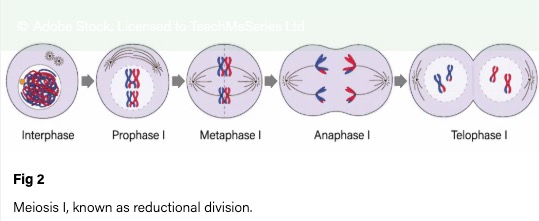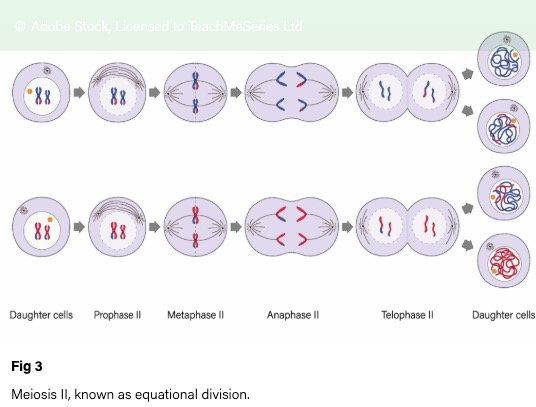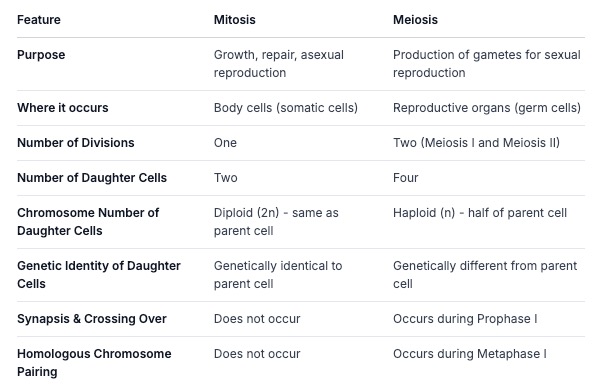Passing on Traits: Meiosis and Fertilization
Passing on Traits: Meiosis and Fertilization
At the end of this lesson, you are expected to:
Describe the process and purpose of meiosis in producing gametes with half the chromosome number.
Identify the stages of meiosis.
Explain why meiosis is important for sexual reproduction.
Imagine you are a detective trying to solve a mystery about how families get their traits! You have two suspects: a "body cell" and a "sex cell."
Body Cell: This cell is like a regular person. It has a full set of instructions (chromosomes) from both its mom and dad. If a person has 46 chromosomes, their body cells will have 46 chromosomes.
Sex Cell: This cell is special because it's used for making babies. It needs to have half the number of instructions so that when it joins with another sex cell, the new baby gets the full set of instructions.
Your Challenge:
If a human body cell has 46 chromosomes, how many chromosomes should a human sex cell have to make sure the baby gets the correct total number of chromosomes?
Why is it important for the sex cell to have fewer chromosomes than the body cell?
Think about it! We'll find out the answers as we explore meiosis.
Hello, future scientists! Last time, we learned about mitosis, the cell's way of making exact copies of itself for growth and repair. Today, we're going on a different kind of cellular adventure – the journey of meiosis! This is a super special type of cell division that's all about making reproductive cells, also called gametes. These are the cells that will eventually join together to create new life.
Think about your parents. You have traits from both of them, right? Maybe you have your mom's eyes and your dad's smile. How does that happen? It's all thanks to meiosis and the special cells it creates: sperm in males and egg cells in females.
Why is Meiosis So Special? The Chromosome Story
Let's go back to our "Chromosome Count Challenge." Remember how a body cell has a full set of chromosomes? In humans, that's 46 chromosomes. These chromosomes come in pairs – one set from your mother and one set from your father. We call this a diploid number, often written as 2n. So, for humans, 2n = 46.
Now, imagine if a sperm cell (with 46 chromosomes) joined with an egg cell (with 46 chromosomes). The resulting baby would have 46 + 46 = 92 chromosomes! That's way too many, and it wouldn't be healthy.
This is where meiosis comes in. Meiosis is like a "reduction division" because it takes a diploid cell (2n) and divides it twice to produce four haploid cells (n). Haploid means having half the number of chromosomes. So, for humans, a haploid cell (a gamete) will have 23 chromosomes (n = 23).
When a sperm (n=23) fertilizes an egg (n=23), they combine to form a new cell called a zygote. This zygote will have 23 + 23 = 46 chromosomes (2n = 46), the correct diploid number for a new human being!
Meiosis: A Two-Act Play
Meiosis is a complex process, but we can think of it as a two-part show: Meiosis I and Meiosis II.
Act I: Meiosis I – Separating the Pairs

Before meiosis begins, the cell makes a copy of all its DNA, just like in mitosis. So, each chromosome now consists of two identical sister chromatids.
Prophase I: This is a very busy stage!
The chromosomes condense and become visible.
The nuclear envelope breaks down.
Synapsis happens: Homologous chromosomes (the pairs of chromosomes, one from mom, one from dad) find each other and pair up. They form structures called bivalents or tetrads (because they have four chromatids in total).
Crossing Over: This is a super important event! While the homologous chromosomes are paired up, they can exchange segments of DNA. Imagine two friends sharing parts of their favorite comic books. This "crossing over" shuffles the genetic information, creating new combinations of traits. This is a major reason why siblings can look similar but not be identical.
Metaphase I:
The homologous chromosome pairs (tetrads) line up in the middle of the cell, along the metaphase plate.
The way these pairs line up is random. This is called independent assortment, and it's another way meiosis creates genetic diversity. Think of it like shuffling a deck of cards – each time you shuffle, you get a different order.
Anaphase I:
The homologous chromosomes are pulled apart and move to opposite ends of the cell.
Crucially, the sister chromatids stay together. It's the pairs of chromosomes that are separated, not the copies within a pair.
Telophase I and Cytokinesis:
The chromosomes arrive at the poles.
The cell may divide into two daughter cells. Each daughter cell is now haploid because it only has one chromosome from each homologous pair. However, each chromosome still consists of two sister chromatids.
Act II: Meiosis II – Separating the Sister Chromatids

Meiosis II is very similar to mitosis. The goal here is to separate the sister chromatids that were copied before Meiosis I.
Prophase II:
If the cell divided in Telophase I, new nuclear envelopes might form briefly and then break down again.
Chromosomes condense again (if they decondensed).
Metaphase II:
The chromosomes (each still made of two sister chromatids) line up in the middle of each cell, along the metaphase plate.
Anaphase II:
The sister chromatids are finally pulled apart and move to opposite ends of the cell. Now they are considered individual chromosomes.
Telophase II and Cytokinesis:
Chromosomes arrive at the poles.
Nuclear envelopes reform around the chromosomes.
The cells divide.
The Result: From one original diploid cell, meiosis produces four haploid daughter cells. Each of these cells is genetically different from the original cell and from each other, thanks to crossing over and independent assortment. These four haploid cells are the gametes (sperm or egg cells).
Real-World Example 1: Making a Baby Human
Let's trace the journey for humans:
Start: A special cell in the ovary (in a female) or testis (in a male) begins meiosis. This cell is diploid (2n = 46 chromosomes).
Meiosis I: The homologous chromosome pairs separate. Two cells are formed, each with 23 chromosomes, but each chromosome still has two sister chromatids.
Meiosis II: The sister chromatids separate. These two cells divide, resulting in a total of four cells. Each of these four cells is haploid (n = 23 chromosomes).
Gametes: In females, these four cells develop into egg cells (ova), though usually only one matures. In males, all four develop into sperm cells.
Fertilization: If a sperm (n=23) meets an egg (n=23), they fuse.
Zygote: The resulting zygote is diploid (2n=46), ready to grow into a new baby through mitosis!
Real-World Example 2: The Life Cycle of a Butterfly
Butterflies also reproduce sexually, and meiosis is key!
Adult Butterfly: The adult butterfly has diploid (2n) body cells.
Gamete Formation: Special cells within the butterfly's reproductive organs undergo meiosis to produce haploid (n) sperm and egg cells.
Fertilization: A sperm cell fertilizes an egg cell, forming a diploid (2n) zygote.
Development: The zygote develops into an embryo, and eventually, a new butterfly larva (caterpillar). The caterpillar grows using mitosis.
Metamorphosis: The caterpillar eventually forms a chrysalis and undergoes metamorphosis to become an adult butterfly, starting the cycle again.
Why is Meiosis Important?
Maintains Chromosome Number: Meiosis ensures that the chromosome number stays constant from one generation to the next in sexually reproducing organisms. Without it, the chromosome number would double with each generation.
Genetic Variation: Crossing over and independent assortment during meiosis create new combinations of genes. This genetic variation is crucial for the survival and adaptation of species. It's why you're unique, and why populations are diverse!
Let's Recap the Key Differences: Mitosis vs. Meiosis

Meiosis is a fundamental process that drives sexual reproduction and ensures the diversity of life on Earth. It's a beautiful example of how cells work together to create something entirely new!
Guided Practice: "Meiosis Matching Game"
Match the stage of meiosis with its correct description. Write the letter of the description next to the stage.
Stages:
Prophase I
Metaphase I
Anaphase I
Telophase I
Prophase II
Metaphase II
Anaphase II
Telophase II
Descriptions: A. Sister chromatids are pulled apart to opposite poles. B. Homologous chromosome pairs line up at the metaphase plate. C. The cell divides, resulting in four haploid daughter cells. D. Homologous chromosomes condense, pair up (synapsis), and crossing over occurs. E. Chromosomes line up at the metaphase plate. F. Homologous chromosomes are separated and move to opposite poles; sister chromatids stay together. G. Chromosomes condense again; nuclear envelope breaks down (if reformed). H. The cell divides into two haploid cells, each with chromosomes still composed of two sister chromatids.
(Self-check: After you finish, compare your answers with a classmate or review the Lesson Proper again.)
Interactive Activity: "Meiosis Flipbook"
Create a simple flipbook to illustrate the stages of meiosis.
Materials:
Several small pieces of paper (or index cards)
Stapler or paper clip
Colored pencils or markers
Instructions:
Take about 8-10 pieces of paper.
Number each piece of paper from 1 to 8 (or 1 to 10 if you want to add more detail).
On the first page, draw a cell with a few pairs of chromosomes (remember to show them as replicated, with two sister chromatids). Label it "Start (Diploid Cell)."
On the following pages, draw each stage of Meiosis I (Prophase I, Metaphase I, Anaphase I, Telophase I). Make sure to show:
Synapsis and crossing over in Prophase I.
Homologous pairs lining up in Metaphase I.
Homologous pairs separating in Anaphase I.
Two cells forming in Telophase I.
On the next pages, draw each stage of Meiosis II (Prophase II, Metaphase II, Anaphase II, Telophase II). Show the two cells from Meiosis I dividing.
Show chromosomes lining up in Metaphase II.
Show sister chromatids separating in Anaphase II.
Show four haploid cells forming in Telophase II.
Staple or clip the pages together on one side to create a flipbook.
Flip through your book to see the process of meiosis in action!
Independent Practice: "Meiosis Diagram Labeling"
Look at the diagram below (imagine a diagram showing the stages of meiosis). Label the key events and structures.


Terms to Label:
Homologous Chromosomes
Sister Chromatids
Centromere
Metaphase Plate
Spindle Fibers
Haploid Cell
Diploid Cell
Crossing Over
Nuclear Envelope
Have you ever wondered why you look different from your siblings, even though you have the same parents? Meiosis is a big reason why!
Crossing Over: When homologous chromosomes exchange pieces in Prophase I, it creates new combinations of genes. This means the sperm and egg cells that make you are genetically unique.
Independent Assortment: The random way homologous pairs line up in Metaphase I also shuffles the genetic deck. The chromosomes you inherit from your mother and father are mixed up in each gamete.
These two processes, crossing over and independent assortment, are like nature's way of mixing and matching traits. They ensure that every new individual created through sexual reproduction is unique, contributing to the amazing diversity of life we see around us, from the different breeds of dogs to the variety of flowers in a garden. This genetic variation is also important because it helps populations adapt to changing environments.
Meiosis is a special type of cell division that produces gametes (sperm and egg cells).
It involves two rounds of division: Meiosis I and Meiosis II.
Meiosis starts with a diploid (2n) cell and ends with four haploid (n) daughter cells.
Haploid cells have half the number of chromosomes as the parent cell.
Crossing over (exchange of genetic material between homologous chromosomes) and independent assortment (random alignment of homologous pairs) during Meiosis I create genetic variation.
Meiosis is essential for maintaining the correct chromosome number in sexually reproducing organisms and for generating genetic diversity.
Explain to a younger sibling or friend: Imagine you have a younger sibling who is curious about how babies are made. Using simple terms and perhaps drawing a picture, explain why a sperm and egg cell need to have fewer chromosomes than a regular body cell.
Create a visual aid: Make a poster or a digital presentation that compares and contrasts mitosis and meiosis. Highlight the key differences in their purpose, process, and outcome.
Research: Find out about a specific animal or plant and how meiosis plays a role in its reproduction. For example, how does meiosis work in flowering plants to produce pollen and ovules?
No Comments Yet